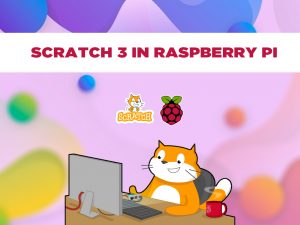SCRATCH 3 IN RASPBERRY PI
Introduction
Scratch is a block-based free education language developed by the Massachusetts Institute of Technology ( MIT) in 2003 and was first released in 2007 publicly. It is easy to go visual programming language targeted especially for students. You can create your project by dragging the programming blocks from the block palette and attaching them with the other blocks according to your program. This type of programming is called “drag and drop programming” and the structure of multiple blocks are called scripts. Scratch allows children to create interactive projects and learn to program.
Many schools even added Scratch in their school curriculum and not only in schools but the scratch is also used in colleges, after school centres and many code clubs. Scratch was developed for educational purpose, to create fun projects and is easy to learn a language. We can create interactive stories, poems, games, projects and many more. Scratch also has a special section for teachers. Till date scratch have 40 million active users and over 40 million projects.
The latest version of scratch is Scratch 3.0 which is released in 2019. You can download it from the Scratch site and even download the older version. Scratch also has an Offline editor on the same site.
SCRATCH 3.0
Scratch 3.0 is the latest version by MIT on January 2, 2019. The new Scratch 3.0 version has some major changes and a completely new look feel. The new design is more soft and modern.
The interface consists of 3 major sections: block palette, stage area and a space for coding and all the programming block arrangements. In the project, all the actions and movements are done by an object called the Sprites, which can be chosen from the sprite library, uploaded or can be user-created. All the actions of the sprites are performed on the stage and you can also use more than one Sprite. The stage area is the place where the results displays(i.e, animations, games, stories, etc) and you can also resize the stage size. All the Sprites thumbnails are listed below the stage. The stage follows the x,y coordinates and at the centre of the stage is the 0,0 coordinate. In the stage you can change the background of the sprites by changing the backdrops. You can select the backdrop from the backdrop section, upload from the system and also can draw it.
On the left-hand side is the block palette, from where you can drag your required block. And if you need more blocks you can also add it from the extensions. Raspberry Pi has its own extensions for its GPIO pins, HATs, etc. Raspberry Pi (Buy Raspberry Pi 4 Clear Cases) comes with preinstalled Scratch and Scratch 2. Once you have selected the block then drag it to the coding area which is in the middle section. You can code the sprite one by one. Scratch also has a Costumes tab which allows the user to change the appearance of the sprite and to give more effects and animations.
MAJOR CHANGES IN SCRATCH 3.0
- The size of the blocks is enlarged slightly.
- Block order is different now.
- The text of the blocks is also different.
- The shades of some blocks are also changed.
- More Blocks is renamed to My Blocks and is given light red colour.
- Paint editor and sound editors are added.
- PicoBoard and LEGO WeDo 1.0 are not supported anymore.
- New extensions are added i.e. Pen, Video Sensing, Music blocks, text to speech, translate, micro:bit and Lego Mindstorms EV3.
- Internet Explorer and other out-dated browsers are removed.
- The position of the stage and block palette are different now.
- Sprite position can be changed by changing the position coordinates.
- You can rename the Sprites names and also can be rotated.
- New sprites and backdrops are introduced.
- Vector paint editor is the new default editor.
- Different fonts are also introduced i.e. Sans Serif, Serif, Handwriting, Marker, Curly, Pixel, Chinese, Japanese and Korean.
- Tutorial Section and project search are also added.
- Now we can choose from dozens of new sounds, characters and backdrops.
RASPBERRY PI AND SCRATCH 3.0
The new Scratch 3 requires at least 1 GB RAM to run. If you are using Raspberry Pi 4 use at least Pi of 2GB RAM. Scratch 3 can run on Raspberry Pi 2, 3, 3B+ with 1 GB RAM, performance may vary according to the lack of memory.
HOW TO INSTALL SCRATCH 3.0 ON RASPBIAN BUSTER
First, start with updating and upgrading the Raspbian.
Type the following commands in the terminal to update Buster and install Scratch:
sudo apt-get update
sudo apt-get install scratch3
INSTALLING SCRATCH 3.0 USING RECOMMENDED SOFTWARE APP
Go to the menu or the raspberry icon on the left corner of the desktop, click on Preferences > Recommended Software, and choose Scratch 3 and click on the OK. It will take some time to download. After the download completes find the Scratch 3 in the Programming section.
RASPBERRY PI EXTENSIONS
GPIO EXTENSIONS
This extension gives you access to connect and control the GPIO pins of your Pi with your
Other devices.
SIMPLE ELECTRONIC EXTENSION
These are the beginner-friendly extension. Simple electronic device blocks are there like LED, BUTTONS, etc. These devices are used for making simple as well as major projects.
SENSE HAT EXTENSION
HAT extension is updated and a number of new features are introduced:
- For displaying characters, numbers and patterns on the LEDs.
- For measuring pressure, humidity and temperature.
- For sensing movements.
- Use the joystick.
SB Components wrote up an entire project SCRATCH 3 in RASPBERRY PI. Go forth and enjoy it!
Please visit our site for more : https://shop.sb-components.co.uk/


